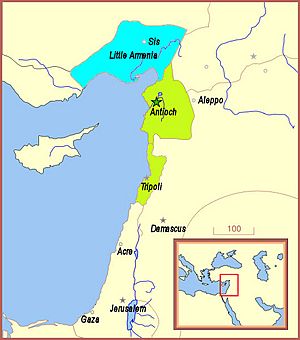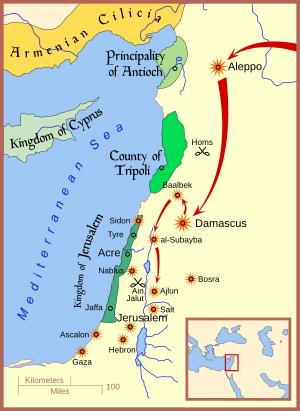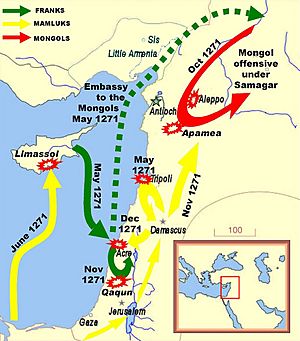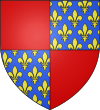Bohemond VI of Antioch facts for kids
Quick facts for kids Bohemond VI of Antioch |
|
|---|---|
| Prince of Antioch | |
| Reign | 1251–1268/1275 |
| Predecessor | Bohemond V of Antioch |
| Successor | Conquered by Baybars |
| Count of Tripoli | |
| Reign | 1251–1275 |
| Predecessor | Bohemond V of Antioch |
| Successor | Bohemond VII |
| Born | c.1237 |
| Died | 1275 (aged 38) |
| Spouse | Sibylla of Armenia |
| Issue | Bohemond, Count of Tripoli Lucia, Countess of Tripoli |
| House | House of Poitiers |
| Father | Bohemond V of Antioch |
| Mother | Lucienne of Segni |
Bohemond VI (born around 1237, died 1275) was an important ruler in the Middle East. He was known as the Fair. From 1251 until his death, he was the prince of Antioch and the count of Tripoli.
Bohemond ruled during a very challenging time. His lands, especially Antioch, were caught between two powerful empires: the Mongol Empire and the Mamluk Sultanate. He decided to make an alliance with the Mongols. His Crusaders even fought alongside the Mongols against the Mamluks.
However, the Mamluks achieved a major victory against the Mongols at the Battle of Ain Jalut. This battle stopped the Mongol advance westward. In 1268, the Mamluks, led by Baybars, captured Antioch. After this, Bohemond was a prince without a land to rule. His son, Bohemond VII, took over his titles after his death.
Contents
Life of Bohemond VI

Bohemond VI was the son of Bohemond V of Antioch and Lucienne of Segni. Lucienne was related to Pope Innocent III. When his father, Bohemond V, passed away in January 1252, Bohemond VI was only 15 years old. He was supposed to rule with his mother as his regent.
But his mother, Lucienne, stayed in Tripoli. She let her relatives manage the government of Antioch. People did not like this. So, young Bohemond VI got permission from Pope Innocent IV to become ruler a few months early. King Louis IX of France, who was on a Crusade at the time, supported this.
Bohemond then traveled to Acre. There, King Louis made him a knight. Bohemond then took power in Antioch. King Louis also helped make peace between Antioch and Cilician Armenia. In 1254, when Bohemond was 17, he married Sibylla. She was the daughter of King Hetoum I of Armenia. This marriage helped end a long power struggle between their two states.
Conflicts and Challenges
Bohemond was also involved in a big fight called the War of Saint Sabas. This war started in 1256. It was a dispute between two powerful trading cities, the Genoese and the Venetians. Many nobles in the Holy Land joined in, wasting valuable resources.
Bohemond tried to get the Genoese to support the Venetians. But a powerful family, the Embriaco lords of Gibelet (modern Byblos), were against him. They rebelled in 1258, leading to a civil war. This conflict lasted for many years. Bohemond managed to get some peace by having the rebel leader, Bertrand Embriaco, killed. However, the bad feelings continued.
Alliance with the Mongols
Bohemond's rule saw a huge conflict between the Mamluks and the Mongols. The Mongol army was moving closer from central Asia. Cilician Armenia and Antioch were right in their path. The Mongols were known for being very fierce. If towns did not surrender quickly, their people were often killed.

King Hetoum I of Armenia, Bohemond's father-in-law, decided it was smart to join the Mongols. He sent his brother to the Mongol court in 1247. Hetoum then convinced Bohemond VI to do the same. So, Antioch became a state that paid tribute to the Mongols in 1260. Both Hetoum and Bohemond fought with their own armies during the Mongol conquests of Aleppo and Damascus in 1260.
The Mongols rewarded Bohemond for his loyalty. They gave him back lands that had been lost to the Muslims. These included places like Lattakieh and Jabala. Bohemond was able to take them back with help from some Templars and Hospitallers.
In return, Bohemond had to allow a Greek church leader, Euthymius, to be in charge in Antioch. This was instead of the usual Latin church leader. The Mongols wanted to strengthen their ties with the Byzantine Empire. This made the Latin Christians in Acre angry. Bohemond was even temporarily removed from the church by the Patriarch of Jerusalem. However, after Bohemond explained his reasons, the new Pope, Pope Urban IV, suspended his excommunication.
After taking Damascus, the main Mongol army had to stop its advance. They had problems within their own empire. Most of the Mongol army left Syria, leaving a smaller force behind. This gave the Egyptian Mamluks a chance. The Mamluks moved north from Cairo to fight the Mongols. They even made a deal with the Franks of Acre to pass through their land peacefully. This allowed the Mamluks to defeat the Mongols at the famous Battle of Ain Jalut in September 1260.
With the Mongol army gone, the Mamluks then conquered Syria and Iran. The Mamluks, led by Baibars, also began to threaten Antioch.
In 1263, Bohemond and Hetoum tried to regain control. They even kidnapped the Greek church leader, Euthymius, and replaced him with a Latin one. They also tried to put financial pressure on the Mamluks. For example, Bohemond and Hetoum controlled forests in southern Anatolia and Lebanon. The Mamluks needed this wood to build ships. Hetoum tried to use this to get a truce. But these actions only made Baibars angrier.
In 1264, Bohemond also sought more help from the Mongols. He traveled to the court of Hulagu, a Mongol ruler. However, Hulagu was not happy that Bohemond had replaced the Greek church leader. The alliance with the Byzantine Empire was important to him.
Loss of Antioch
In 1266, Hetoum also went to the Mongol court to ask for help. But while he was away, the Mamluk army attacked the Armenian army. This happened at the Battle of Mari. The Mamluks won. They killed one of Hetoum's sons and captured another. They also destroyed Cilician Armenia, including its capital city.
After destroying Cilicia, the Mamluk army then turned towards Antioch. But the Mamluk generals had taken a lot of treasure from Armenia. They were not eager for another battle. So, Bohemond was able to pay them to stop them from attacking.
Baibars was angry at his generals for being weak. He returned to attack. In May 1267, he attacked Acre. In 1268, he began the Siege of Antioch. He captured the city while Bohemond was away in Tripoli. All of northern Syria was quickly lost. This left Bohemond with no lands except Tripoli.
Siege of Tripoli

Baibars attacked again in 1271. He started the Siege of Tripoli. He sent a letter to Bohemond, threatening to completely destroy him. He also made fun of Bohemond's alliance with the Mongols.
Bohemond asked for a truce so he would not lose Tripoli too. Baibars made fun of him for not being brave enough. He asked Bohemond to pay for all the Mamluk army's costs. Bohemond refused this offer. But in May, Baibars offered him a truce anyway.
By this time, the Mamluks had captured almost all the inland castles of the Franks. However, the Mamluks had heard about a new Crusade coming. This one was from the prince who would later become Edward I of England. Edward landed in Acre on May 9, 1271. Bohemond and his cousin, King Hugh III of Cyprus, soon joined him.
Bohemond died in 1275. He left behind a son and three daughters. His son was Bohemond VII, who became the count of Tripoli and the prince of Antioch (even though Antioch no longer existed). His daughters were Isabelle (who died young), Lucia (who later became countess of Tripoli), and Marie.
The Mamluks remained angry about Bohemond VI's alliance with the Mongols. This anger lasted until 1289, when Tripoli finally fell in the Fall of Tripoli.
See also
 In Spanish: Bohemundo VI de Antioquía para niños
In Spanish: Bohemundo VI de Antioquía para niños


